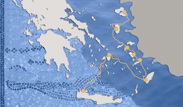The monastery of Agios Ioannis Theologos
The
Monastery of Agios Ioannis Theologos on Patmos is
a unique example of medieval monastic architecture and a place of considerable
religious interest, being one of the largest monasteries in the Aegean. Tradition has it that John, the beloved disciple
of Jesus, was exiled to barren Patmos in around 95 AD, during the persecutions
of Emperor Domitian; it was during his stay on the island that John wrote two
of the religious texts central to Christian faith, the Gospel According to John
and the Apocalypse. Inextricably linked to this tradition is the founding of
the monastery by Blessed Christodoulos Latrinus in 1088.
Having petitioned
Emperor Alexius I Comnenus , he managed to secure a chrysobull
, he managed to secure a chrysobull granting him the
island and other privileges so as to found a monastery dedicated to the
Evangelist.
granting him the
island and other privileges so as to found a monastery dedicated to the
Evangelist.
The monastery was erected on the summit of the hill, over the
remains of an ancient temple and an early Christian basilica
basilica . Over time
the settlement known as Chora (the island capital) grew up around it, merging
to form a densely built and labyrinthine architectural ensemble.
. Over time
the settlement known as Chora (the island capital) grew up around it, merging
to form a densely built and labyrinthine architectural ensemble.
The monastery complex
is surrounded by an irregularly shaped, many sided medieval wall 15 m in
height. The interior is on several levels, including cell wings, auxiliary
buildings, galleries and chapels dating to the 16th and 17th century, built
around the catholicon
dating to the 16th and 17th century, built
around the catholicon as their focal point. The latter is a late 11th
century composite four-column cross-in-square church
as their focal point. The latter is a late 11th
century composite four-column cross-in-square church , with attached chapels
dedicated to the Virgin Mary and Christodoulos. The surviving wall paintings
, with attached chapels
dedicated to the Virgin Mary and Christodoulos. The surviving wall paintings are fine, rarely encountered depictions of evangelical scenes probably painted
by a Cretan School artist, dating from the second decoration
phase in the early 17th century. The chapel of the Virgin Mary has an important
fresco ensemble displaying the monumental tendency of the late 12th century.
The famed monastery library and sacristy house treasures and heirlooms of inestimable
historical and artistic value, such as rare collections of Byzantine and post-Byzantine
manuscripts, imperial documents, books, icons and miniature works. The Monastery
of Agios Ioannis Theologos on Patmos (an
impressive architectural monument and repository of Byzantine culture), the
Cave of the Apocalypse and Chora (Patmos town)
were placed on the UNESCO World Heritage List in 1999, as a prominent Greek
Orthodox pilgrimage centre of outstanding architectural interest.
are fine, rarely encountered depictions of evangelical scenes probably painted
by a Cretan School artist, dating from the second decoration
phase in the early 17th century. The chapel of the Virgin Mary has an important
fresco ensemble displaying the monumental tendency of the late 12th century.
The famed monastery library and sacristy house treasures and heirlooms of inestimable
historical and artistic value, such as rare collections of Byzantine and post-Byzantine
manuscripts, imperial documents, books, icons and miniature works. The Monastery
of Agios Ioannis Theologos on Patmos (an
impressive architectural monument and repository of Byzantine culture), the
Cave of the Apocalypse and Chora (Patmos town)
were placed on the UNESCO World Heritage List in 1999, as a prominent Greek
Orthodox pilgrimage centre of outstanding architectural interest.
Bibliography (3)▼
Comments (0)▼
New Comment▼








